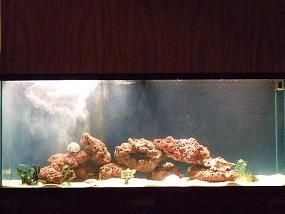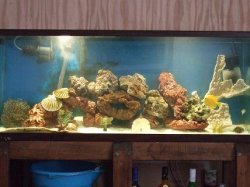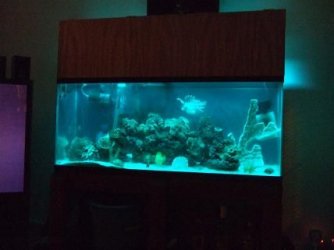Lyle
New Member
so i'm trying my hand at making my own live rock, because i'm a cheap college student and don't want to pay 500 bucks (possibly more) on some rocks. heres a few pics of my progress with the project, and what i did to get this far.
heres a sample pic of what i have right now, and a few other pics, tell me what you think!




that last one is just how i'm curing the rock, its in a 10 gallon tank with a single power head just for water flow.
few suggestions to begin with... wear gloves, my fingers are covered in blisters from mixing the cement and aragonite by hand. also, plan ahead to keep the mess down. i'm really impatient and made a total mess of my bathroom (wish i had a garage but like a said, i'm a cheap college student), and its gonna be a while before its clean again.
so heres how i did it:
portland cement type I/II
red and brown cement coloring
lots of aragonite, and some regular sand.
all of these except the aragonite can be found at lowes and home depot, just ask for em. aragonite can be found at most any fish store.
mix the cement with water and use about 1 part cement to about 3-5 parts aragonite. mold as desired (make sure you don't smooth it out, it looks much more natural when its lumpy!) to get holes and crevises, i just pushed globs of sand into the still soft cement and washed it away later.
to dry it i used regular sand, which is what you see still stuck to the brownish rocks, the really red one was mostly left out of the sand. i wish i had used more aragonite to lay the soon-to-rocks on instead but i went cheap. i still think it looks pretty good.
i filled a few large bins half way with sand, placed the soon-to-be rock in the sand and burried it. the red lookin one i did not burry, so if you want it to look more like that, don't burry it. i let em all sit in the sand for about 24 hours.
i'm in the process of curing them right now in that 10 gallon tank. basically i'm just gonna leave em in there, change the water every day and wait till the pH is stable at about 8.
tell me what you think, offer suggestions, and gimme some tips on how to cure the rocks faster cuz i can't wait to put them in my tank!
UPDATE! So i've heard alot of mixed feeling about curing the rock with vinegar. after letting the rock cure in water for about a week and a half i tried it out. bought about 6 gallons of it, put it in a that 10 gallon tank with the rock and filled it the rest of the way with water and let it sit for about 4 days. Then let a single peice sit it fresh water for a day and tested the pH afterwards. if it was 8 or above i put it back and let it sit another day. when the rock didn't chance the pH of the faucet water i put it in the tank.
heres a sample pic of what i have right now, and a few other pics, tell me what you think!




that last one is just how i'm curing the rock, its in a 10 gallon tank with a single power head just for water flow.
few suggestions to begin with... wear gloves, my fingers are covered in blisters from mixing the cement and aragonite by hand. also, plan ahead to keep the mess down. i'm really impatient and made a total mess of my bathroom (wish i had a garage but like a said, i'm a cheap college student), and its gonna be a while before its clean again.
so heres how i did it:
portland cement type I/II
red and brown cement coloring
lots of aragonite, and some regular sand.
all of these except the aragonite can be found at lowes and home depot, just ask for em. aragonite can be found at most any fish store.
mix the cement with water and use about 1 part cement to about 3-5 parts aragonite. mold as desired (make sure you don't smooth it out, it looks much more natural when its lumpy!) to get holes and crevises, i just pushed globs of sand into the still soft cement and washed it away later.
to dry it i used regular sand, which is what you see still stuck to the brownish rocks, the really red one was mostly left out of the sand. i wish i had used more aragonite to lay the soon-to-rocks on instead but i went cheap. i still think it looks pretty good.
i filled a few large bins half way with sand, placed the soon-to-be rock in the sand and burried it. the red lookin one i did not burry, so if you want it to look more like that, don't burry it. i let em all sit in the sand for about 24 hours.
i'm in the process of curing them right now in that 10 gallon tank. basically i'm just gonna leave em in there, change the water every day and wait till the pH is stable at about 8.
tell me what you think, offer suggestions, and gimme some tips on how to cure the rocks faster cuz i can't wait to put them in my tank!
UPDATE! So i've heard alot of mixed feeling about curing the rock with vinegar. after letting the rock cure in water for about a week and a half i tried it out. bought about 6 gallons of it, put it in a that 10 gallon tank with the rock and filled it the rest of the way with water and let it sit for about 4 days. Then let a single peice sit it fresh water for a day and tested the pH afterwards. if it was 8 or above i put it back and let it sit another day. when the rock didn't chance the pH of the faucet water i put it in the tank.






 . I love the rocks once again im jealous of how crafty people can be on this forum
. I love the rocks once again im jealous of how crafty people can be on this forum 

